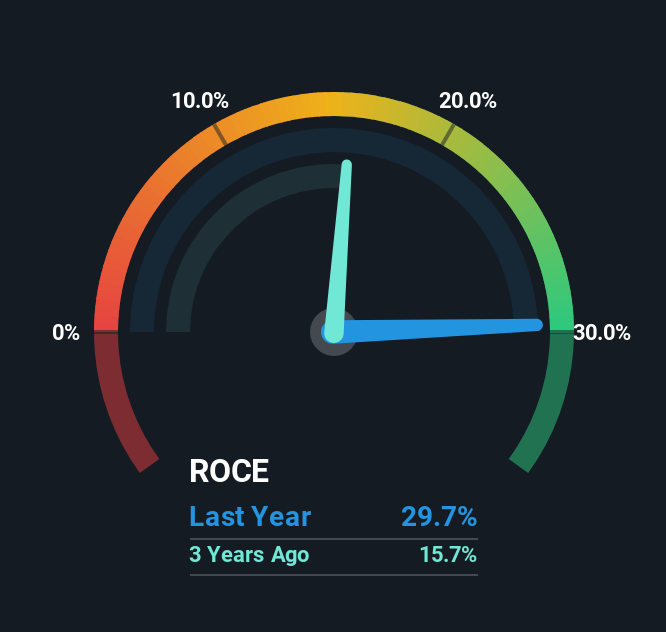- India
- /
- Electrical
- /
- NSEI:VMARCIND
Here's What V-MARC India's (NSE:VMARCIND) Strong Returns On Capital Mean
If we want to find a potential multi-bagger, often there are underlying trends that can provide clues. Amongst other things, we'll want to see two things; firstly, a growing return on capital employed (ROCE) and secondly, an expansion in the company's amount of capital employed. Ultimately, this demonstrates that it's a business that is reinvesting profits at increasing rates of return. That's why when we briefly looked at V-MARC India's (NSE:VMARCIND) ROCE trend, we were very happy with what we saw.
What Is Return On Capital Employed (ROCE)?
If you haven't worked with ROCE before, it measures the 'return' (pre-tax profit) a company generates from capital employed in its business. The formula for this calculation on V-MARC India is:
Return on Capital Employed = Earnings Before Interest and Tax (EBIT) ÷ (Total Assets - Current Liabilities)
0.30 = ₹795m ÷ (₹6.5b - ₹3.8b) (Based on the trailing twelve months to March 2025).
Thus, V-MARC India has an ROCE of 30%. In absolute terms that's a great return and it's even better than the Electrical industry average of 18%.
View our latest analysis for V-MARC India

Historical performance is a great place to start when researching a stock so above you can see the gauge for V-MARC India's ROCE against it's prior returns. If you're interested in investigating V-MARC India's past further, check out this free graph covering V-MARC India's past earnings, revenue and cash flow.
The Trend Of ROCE
In terms of V-MARC India's history of ROCE, it's quite impressive. Over the past five years, ROCE has remained relatively flat at around 30% and the business has deployed 542% more capital into its operations. With returns that high, it's great that the business can continually reinvest its money at such appealing rates of return. If V-MARC India can keep this up, we'd be very optimistic about its future.
On a separate but related note, it's important to know that V-MARC India has a current liabilities to total assets ratio of 58%, which we'd consider pretty high. This can bring about some risks because the company is basically operating with a rather large reliance on its suppliers or other sorts of short-term creditors. Ideally we'd like to see this reduce as that would mean fewer obligations bearing risks.
The Key Takeaway
In short, we'd argue V-MARC India has the makings of a multi-bagger since its been able to compound its capital at very profitable rates of return. And the stock has done incredibly well with a 1,034% return over the last three years, so long term investors are no doubt ecstatic with that result. So even though the stock might be more "expensive" than it was before, we think the strong fundamentals warrant this stock for further research.
V-MARC India does come with some risks though, we found 3 warning signs in our investment analysis, and 2 of those shouldn't be ignored...
High returns are a key ingredient to strong performance, so check out our free list ofstocks earning high returns on equity with solid balance sheets.
New: Manage All Your Stock Portfolios in One Place
We've created the ultimate portfolio companion for stock investors, and it's free.
• Connect an unlimited number of Portfolios and see your total in one currency
• Be alerted to new Warning Signs or Risks via email or mobile
• Track the Fair Value of your stocks
Have feedback on this article? Concerned about the content? Get in touch with us directly. Alternatively, email editorial-team (at) simplywallst.com.
This article by Simply Wall St is general in nature. We provide commentary based on historical data and analyst forecasts only using an unbiased methodology and our articles are not intended to be financial advice. It does not constitute a recommendation to buy or sell any stock, and does not take account of your objectives, or your financial situation. We aim to bring you long-term focused analysis driven by fundamental data. Note that our analysis may not factor in the latest price-sensitive company announcements or qualitative material. Simply Wall St has no position in any stocks mentioned.
About NSEI:VMARCIND
V-MARC India
Manufactures and markets electrical wires and cables under the V-Marc brand name in India.
Solid track record with adequate balance sheet.
Similar Companies
Market Insights
Community Narratives


Recently Updated Narratives

Astor Enerji will surge with a fair value of $140.43 in the next 3 years

Proximus: The State-Backed Backup Plan with 7% Gross Yield and 15% Currency Upside.


A case for for IMPACT Silver Corp (TSXV:IPT) to reach USD $4.52 (CAD $6.16) in 2026 (23 bagger in 1 year) and USD $5.76 (CAD $7.89) by 2030
Popular Narratives


MicroVision will explode future revenue by 380.37% with a vision towards success


The company that turned a verb into a global necessity and basically runs the modern internet, digital ads, smartphones, maps, and AI.



